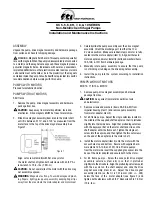
23
VI
、
Fault-finding and Troubleshooting Checklist
Fault
Causes
Troubleshooting
The motor cannot
be started
1. Power failure
2. One-phase or two-phase power
failure;
3. The thermal overload protection
device is on;
4. The motor is damaged;
5. The control system is
interlocked
with
the
pressure-sensitive sensor for pump
diaphragm rupture.
1. Check the power supply;
2. Check whether the fuse and contactor contacts are in good
conditions;
3. Reset the overload;
4. Replace the motor;
No liquid or
insuffient liquid is
discharged from
the pump
1. The suction pipe is blocked or
the suction pipe valve is not
opened;
2. The suction line leaks;
3. The suction pipe is too long
with excessive sharp turns;
4. The surfaces of inlet and outlet
valves are damaged or foreign
matters fall into it, resulting in that
the valve surface is not tightly
sealed;
5. Some air is left in the
diaphragm chamber ;
6. The exhaust safety valve and oil
makeup valve are not tightly
sealed;
7. Dirt falls into the hydraulic oil
and the filter hole of oil makeup
valve is blocked;
8. The piston ring is severely worn
out, and is not tightly sealed;
9. The rotating speed of motor is
1. Check the suction pipe and pipe filter, and open the valve;
2. Check the seal leakage;
3. Increase the diameter of the suction pipe and reduce sharp
turns;
4. Check the airtightness of valve surface and replace the
valve ball and valve seat if necessary; check whether the
liquid is insoluble, crystallizable or solid;
5. Remove the safety overflow valve and fill oil into the
diaphragm chamber for exhausting; or check whether the
connections between one-way valve/liquid valve of the
pressure-sensitive sensor and the cylinder head are reliably
sealed;
6. Check and manually grind the sealing surface, and adjust
the clearance of the exhaust valve spool or set pressure for
opening of the safety valve;
7. Replace the oil and clean the filter of the oil makeup valve;
8. Check or replace the piston ring and piston cylinder;
9. Provide stabilized power supply;
10. Improve the technology, and adjust the height of suction
level.





































